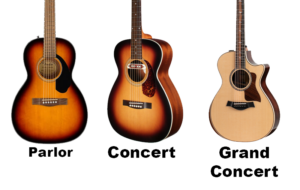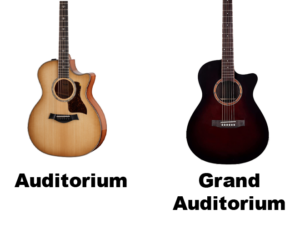Uncategorized
Rock On with the A5 Chord Guitar: Unleash Power and Energy
Hello, fellow guitar enthusiasts and music lovers! Are you ready to dive into the electrifying world of the A5 chord guitar? Today, we’re delving into the realm of rock and power chords as we explore the mighty A5 chord – a driving force that adds raw energy and excitement to your playing. Whether you’re a budding guitarist ready to ignite the stage or a curious soul eager to understand the foundation of rock music, this guide will introduce you to the dynamic universe of the “A5 Chord Guitar.” So, pick up your guitar, plug in, and let’s embark on a journey filled with sonic power and musical intensity!
Unleashing the A5 Chord Guitar: The Essence of Power Chords
Think of the A5 chord as a musical powerhouse that forms the backbone of many rock and alternative tunes. This chord’s simplicity and raw intensity create an undeniable sense of power and drive, making it a quintessential element of rock music. Just like a lightning bolt on a stormy night, the A5 chord strikes with energy and sets the stage for electrifying performances.
Mastering the A5 Chord Guitar: Crafting Sonic Thunder
Let’s dive into the mechanics of forming the A5 chord on your guitar. Follow these steps:
1. Finger Placement: Begin by placing your index finger on the 2nd fret of the D string (the fourth thickest string), marking the root note (A).
2. Ring Finger: Position your ring finger on the 2nd fret of the G string (the third thickest string), forming the perfect fifth (E).
3. Strumming: Focus on strumming the A and D strings (the fourth and fifth thickest strings) while avoiding the low E string (the thickest string). You can also strum all three strings (A, D, and G) for a fuller sound.
4. Sound Check: Strum the strings individually to ensure each note rings out clearly. Adjust finger placement if needed for a powerful sound.
Exploring A5 Chord Guitar Variations: Adding Depth
While the A5 chord is inherently simple, you can add variations to enhance its sonic palette. Here are a couple of ways to experiment:
1. Add Distortion: Plug into an amplifier and apply distortion for a gritty and edgy sound that’s characteristic of rock music.
2. Palm Muting: Experiment with palm muting by resting the edge of your hand lightly on the strings near the bridge. This technique adds a percussive and rhythmic quality to your A5 chord progressions.
The A5 Chord Guitar in Action: Rock Anthems
The A5 chord’s raw power has fueled countless rock anthems. Here are a few iconic songs that showcase the might of the A5 chord:
1. “Smoke on the Water” by Deep Purple: The legendary riff that kicks off this classic tune is built around the A5 chord, creating an instantly recognizable and unforgettable sound.
2. “Blitzkrieg Bop” by Ramones: The driving force behind the punk rock revolution, the A5 chord propels the energetic and rebellious spirit of this timeless track.
Tips for Mastering the A5 Chord Guitar
As you dive into the world of the A5 chord, consider these tips to enhance your playing:
1. Focus on Precision: Strive for clean and precise strumming to ensure each note rings out clearly.
2. Experiment with Rhythm: Vary your strumming patterns to add rhythmic interest and dynamic flair to your A5 chord progressions.
3. Combine with Other Chords: Mix the A5 chord with other power chords or open chords to create dynamic chord progressions.
Conclusion: Embrace the Power of the A5 Chord Guitar
Congratulations, you’ve embarked on a thrilling journey through the electrifying realm of the A5 chord guitar. As you unleash power chords, experiment with variations, and rock out to iconic tunes, you’ll discover the A5 chord’s ability to captivate audiences and infuse your music with raw energy. Keep practicing, keep experimenting, and keep embracing the captivating allure of the A5 chord. It’s your gateway to a world of musical intensity, where each strum reverberates with sonic thunder. So, plug in, turn up the volume, and let the invigorating world of the A5 chord guitar propel you into a realm of melodies that ignite the soul and ignite the stage, one powerful chord at a time!
Uncategorized
Acoustic Guitar Sizes: Finding Your Perfect Fit
Have you ever wondered how the size of an acoustic guitar affects its sound? From the intimate, focused tones of a parlor guitar to the deep, resonant sound of a jumbo, the size and shape of an acoustic guitar can have a profound impact on its sonic characteristics.”
In this article, we’ll explore acoustic guitar sizes, their variations, and how to choose the perfect size that suits your needs.
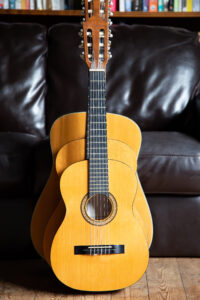 Understanding Acoustic Guitar Sizes: A Musical Puzzle
Understanding Acoustic Guitar Sizes: A Musical Puzzle
Acoustic guitar sizes refer to the dimensions and proportions of the guitar body, which significantly influence the instrument’s tonal characteristics, projection, and playability.
Just like pieces of a musical puzzle, different sizes create distinct voices that cater to various playing styles and preferences.
The Spectrum of Acoustic Guitar Sizes
Acoustic guitars come in several sizes, each with its unique qualities and attributes. Let’s explore some common acoustic guitar sizes and their defining features:
-
-
Parlor Guitar: The parlor guitar is petite and charming, making it an ideal companion for intimate settings.
The name comes from the rooms in which the guitar was typically played in the late 19th century.
Some famous musicians who have been known to use the parlor guitar are, Eric Clapton, Mark Orton, Ed Sheehan, and John Mayer
Its smaller size results in a focused and balanced sound, perfect for fingerpicking and folk music.
-
Concert Guitar: Slightly larger than the parlor guitar, the concert guitar offers enhanced projection and volume. It strikes a balance between portability and sound, making it versatile for various genres.
It is often used in classical music and flamenco music with its full sound.
-
Grand Concert Guitar: With a larger body than the concert guitar, the grand concert guitar boasts a fuller sound and improved tonal complexity.
A popular choice for those who have a smaller stature and require an instrument that’s built to a shorter scale. Great choice for traveling musicians who often play live performances.
It’s suitable for fingerstyle playing and intricate arrangements.
-
Auditorium Guitar: The auditorium guitar, also known as the orchestra model (OM), features a well-rounded sound with a pronounced midrange.
More shallower than the dreadnought and narrower in width than a concert guitar. An Auditorium guitar brings the body closer to the player, making it feel more intimate and comfortable for stage use.
Some famous musicians who play it include Ed Sheeran, John Mayer, and Eric Clapton.
-
Grand Auditorium Guitar: Expanding on the auditorium guitar’s design, the grand auditorium guitar offers a versatile sound profile with enhanced bass response and overall volume.
It is a versatile mid-sized guitar that is a good choice for those who want a single guitar to travel with. The tone is great for strumming and picking. It performs well on stage and in the studio.
It suits a wide range of musical genres.
-
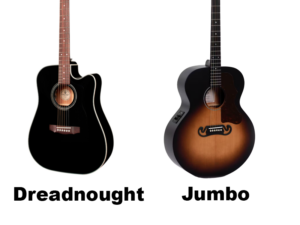 Dreadnought Guitar: The Dreadnought is a true icon, known for its bold and powerful sound. Its large body produces a strong bass response, making it ideal for strumming and vocal accompaniment.
Dreadnought Guitar: The Dreadnought is a true icon, known for its bold and powerful sound. Its large body produces a strong bass response, making it ideal for strumming and vocal accompaniment.This guitar is known for its powerful voice and lower-mid-rich tones that make it a favored choice for country artists. Although it is a popular choice for musicians of all genres.
Some famous musicians who play the dreadnought guitar include Hank Williams Jr, Elvis Presley, Keith Richards, Thom Yorke, and Kurt Cobain.
The original dreadnought guitars were made for the Oliver Ditson Company and featured mahogany backs and sides and spruce tops.
-
Jumbo Guitar: The jumbo guitar lives up to its name with a massive body that delivers robust volume and a deep bass presence.
This is the largest of the guitar family with a deeper body than the popular dreadnought. The body is wider and deeper than traditional acoustic guitars, which gives them a unique appearance.
Jumbo’s are well suited to rhythm guitarists in country and folk rock, and produce a deep rich sound favored by heavy strummers. Some famous musicians who play this guitar are Elvis Presley, George Harrison of the Beatles, Neil Young, Sheryl Crow, and Pete Townshend of The Who.
Choosing the Right Acoustic Guitar Size for You
Selecting the right acoustic guitar size involves considering factors such as playing style, comfort, and tonal preferences. Here are some steps to guide you on your quest:
-
Identify Your Playing Style: Determine whether you lean towards fingerpicking, strumming, or a mix of both. Different sizes excel in different playing styles, so choose one that complements your technique.
-
Consider Body Comfort: Hold and play guitars of various sizes to assess comfort. A guitar that fits well against your body ensures a pleasant playing experience, especially during extended sessions.
-
Evaluate Sound Preferences: Listen to the sound produced by different acoustic guitar sizes. Pay attention to tonal qualities, such as warmth, brightness, and projection, to find the one that resonates with your musical taste.
The Influence of Acoustic Guitar Sizes on Music
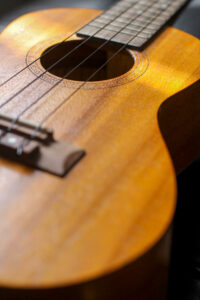 Acoustic guitar sizes and shapes can have a significant impact on the sound of the instrument.
Acoustic guitar sizes and shapes can have a significant impact on the sound of the instrument.The size of the guitar body type also relates to the volume of air within the instrument. Changes to the air capacity of the body will emphasize specific frequencies. A smaller body will have a more focused sound centered on higher frequencies, while a larger body will produce deeper low-end frequencies.
Body dimensions can provide some indication of the tone you might expect, but other factors exert a profound influence, too. Much depends on the tonewoods used to construct the body and the shape, size, and layout of the braces.
Finding Harmony in Acoustic Guitar Sizes
By delving into the nuances of size, sound, and playability, you’ve gained insights that will guide you toward the perfect fit for your musical aspirations.
As you continue your exploration, remember that each acoustic guitar size has its own unique voice and character. Embrace the joy of trying different sizes, celebrate the nuances of their sounds, and let your heart lead you to the one that resonates with your musical soul.
-
Uncategorized
Mastering the Asus Chord on Guitar: Elevate Your Melodic Journey
Greetings, fellow guitar enthusiasts and budding musicians! Are you ready to embark on a melodious adventure and explore the captivating realms of the Asus chord on guitar? Today, we’ll dive into the harmonious world of this versatile chord, unraveling its secrets and understanding how to play it with finesse. Whether you’re a beginner eager to expand your chord repertoire or a curious soul seeking to enhance your musical skills, this guide is your gateway to mastering the alluring “Asus chord guitar.” So, grab your guitar, find a cozy spot, and let’s dive into the harmonious realm of musical expression and creativity!
Demystifying the Asus Chord: A Harmonic Exploration
Imagine the Asus chord as a musical puzzle piece, waiting to be placed within the grand mosaic of your guitar playing. This chord, also known as A suspended chord, holds the power to evoke emotions and add depth to your musical creations. Let’s embark on a journey to unravel the enchanting mechanics of the Asus chord and bring its harmonious magic to life.
Playing the Asus Chord: Crafting Musical Brilliance
To play the Asus chord, follow these simple steps:
1. Finger Placement: Begin by placing your index finger on the 2nd fret of the D string (the fourth thickest string), marking the note A.
2. Middle Finger: Position your middle finger on the 2nd fret of the G string (the third thinnest string), creating the major second (B).
3. Ring Finger: Place your ring finger on the 3rd fret of the B string (the second thinnest string), forming the perfect fourth (E).
4. Strumming: Focus on strumming the A, D, G, and B strings (the thickest through second thinnest strings) while avoiding the high E string (the first string).
5. Sound Check: Strum the strings individually to ensure each note rings out clearly. Adjust finger placement if needed for a resonant sound.
Exploring Asus Chord Variations: Adding Flavor to Your Playing
While the Asus chord is inherently captivating, you can add variations to your playing to create different moods and atmospheres. Here are a couple of ways to experiment:
1. Fingerpicking Patterns: Delve into fingerpicking techniques to create intricate patterns that highlight the individual notes of the Asus chord.
2. Arpeggios: Practice playing the notes of the Asus chord individually in a sequence, crafting arpeggios that flow like a gentle stream.
The Asus Chord in Action: Musical Styles
The Asus chord’s versatility makes it a favorite choice across various musical genres. Here are a few popular songs that feature the Asus chord:
1. “Hotel California” by Eagles: The Asus chord contributes to the iconic intro of this timeless rock classic, setting the stage for a captivating musical journey.
2. “I’m Yours” by Jason Mraz: This feel-good tune features the Asus chord, infusing the melody with a sense of optimism and joy.
Tips for Mastering the Asus Chord
As you embark on your journey to master the Asus chord, consider these tips to enhance your playing:
1. Practice Regularly: Dedicate consistent practice sessions to build muscle memory and familiarity with the Asus chord.
2. Smooth Chord Transitions: Work on transitioning smoothly between the Asus chord and other chords to improve your overall playing fluency.
3. Experiment with Strumming Patterns: Vary your strumming patterns to explore different rhythmic possibilities and enhance your musical expression.
Conclusion: Embrace the Elegance of the Asus Chord
Congratulations, you’ve delved into the harmonious world of the Asus chord on guitar! As you strum, experiment with variations, and play songs, you’ll uncover the power of this chord to add depth, texture, and intrigue to your musical creations. Keep practicing, keep exploring, and keep embracing the enchanting allure of the Asus chord. It’s your key to unlocking a world of musical expression, where each note resonates with elegance and allure. So, pick up your guitar, let your fingers dance across the strings, and let the captivating Asus chord guide you toward a realm of melodies that captivate the senses and elevate the spirit, one harmonious note at a time!
Uncategorized
Striking the Right Chord: Unveiling the Art of Guitar Pick Thickness
In the enchanting realm of music, every choice a musician makes contributes to the symphony of sound they create. When it comes to playing the guitar, one seemingly small decision—the thickness of the guitar pick—can have a significant impact on the tone, technique, and overall experience. Whether you’re a seasoned strummer or a budding guitarist, understanding the nuances of guitar pick thickness is a key step in shaping your sonic journey. This article will take you on a harmonious exploration of the world of guitar pick thickness, revealing how this seemingly modest piece of plastic can wield a profound influence on your musical expression.
The Spectrum of Thickness
Guitar picks come in a variety of thicknesses, ranging from paper-thin to heavy-duty. The measurement of pick thickness is often denoted in millimeters, with thinner picks having lower measurements and thicker ones having higher measurements. As a guitarist, your choice of pick thickness can influence several aspects of your playing:
1. Tone and Texture: The thickness of your guitar pick can significantly alter the tone produced by your instrument. Thinner picks tend to produce a brighter, crisper sound with more high frequencies, while thicker picks can result in a warmer, mellower tone with enhanced low frequencies. The texture of the pick, whether smooth or textured, can further affect the attack and resonance of each note.
2. Strumming and Picking Technique: The thickness of the pick can influence your strumming and picking technique. Thinner picks are well-suited for strumming and creating a fluid motion across the strings. On the other hand, thicker picks provide more resistance, making them ideal for precision picking and intricate patterns.
3. Articulation and Control: Thinner picks offer greater flexibility, allowing for easier bending and vibrato techniques. Thicker picks provide enhanced control and articulation, making it easier to execute precise and accurate note changes.
4. Speed and Shredding: For guitarists who indulge in speedy solos and shredding, the thickness of the pick can impact your ability to glide across the strings effortlessly. Thinner picks may be favored by those seeking rapid picking, while thicker picks can offer stability and control at high speeds.
Finding Your Perfect Match
Choosing the right pick thickness is a personal journey that depends on your playing style, musical preferences, and the sound you wish to achieve. Here are some tips to help you find your perfect match:
1. Experimentation: Begin by experimenting with picks of different thicknesses. Play the same passage using picks of varying thicknesses to compare the tonal differences and how each pick feels in your hand.
2. Genre and Style: Consider the genre of music you enjoy playing. Thicker picks may be preferred for genres like rock, metal, and jazz, while thinner picks could be suitable for folk, pop, or acoustic styles.
3. Comfort and Feel: Pay attention to how comfortable each pick feels in your hand. Some guitarists prefer the flexibility of thinner picks, while others find the stability of thicker picks more suitable.
4. Adaptation: Keep in mind that your preference for pick thickness may evolve over time. As your playing style and technique develop, you might find that your ideal pick thickness changes as well.
Conclusion
The world of guitar pick thickness is a captivating journey that invites you to explore the realms of tone, technique, and personal expression. As you strum, pluck, and unleash melodies upon the strings of your guitar, remember that the thickness of your pick is a silent collaborator in the creation of your musical masterpiece. Whether you’re unleashing powerful riffs, crafting delicate melodies, or embarking on an electrifying solo, the pick you choose holds the power to shape the very essence of your sound. So, venture forth with curiosity and an open ear, and let the quest for the perfect guitar pick thickness be a delightful symphony of discovery in your musical odyssey.
-
advanced9 years ago
How to Play “Sleepwalk” on the 3-String Guitar! Guitar TABs Included!
-
beginner8 years ago
3-String or 4-String? How to Decide Which is Right for You!
-
beginner9 months ago
Exploring Different Guitar Types: A Beginner’s Guide
-
Blues Guitar8 years ago
Go-To Tunings for Blues Slide Guitar
-
advanced9 months ago
Fun and Effective Guitar Exercises: Elevate Your Playing with These 5 Simple Techniques
-
Uncategorized9 months ago
Acoustic Guitar Sizes: Finding Your Perfect Fit
-
Blues Guitar7 years ago
Jack Daniel’s Whiskey Barrel Guitar: How It’s Made and What it Sounds Like
-
Guitars9 months ago
Bass vs Guitar: Exploring the Musical Journey

